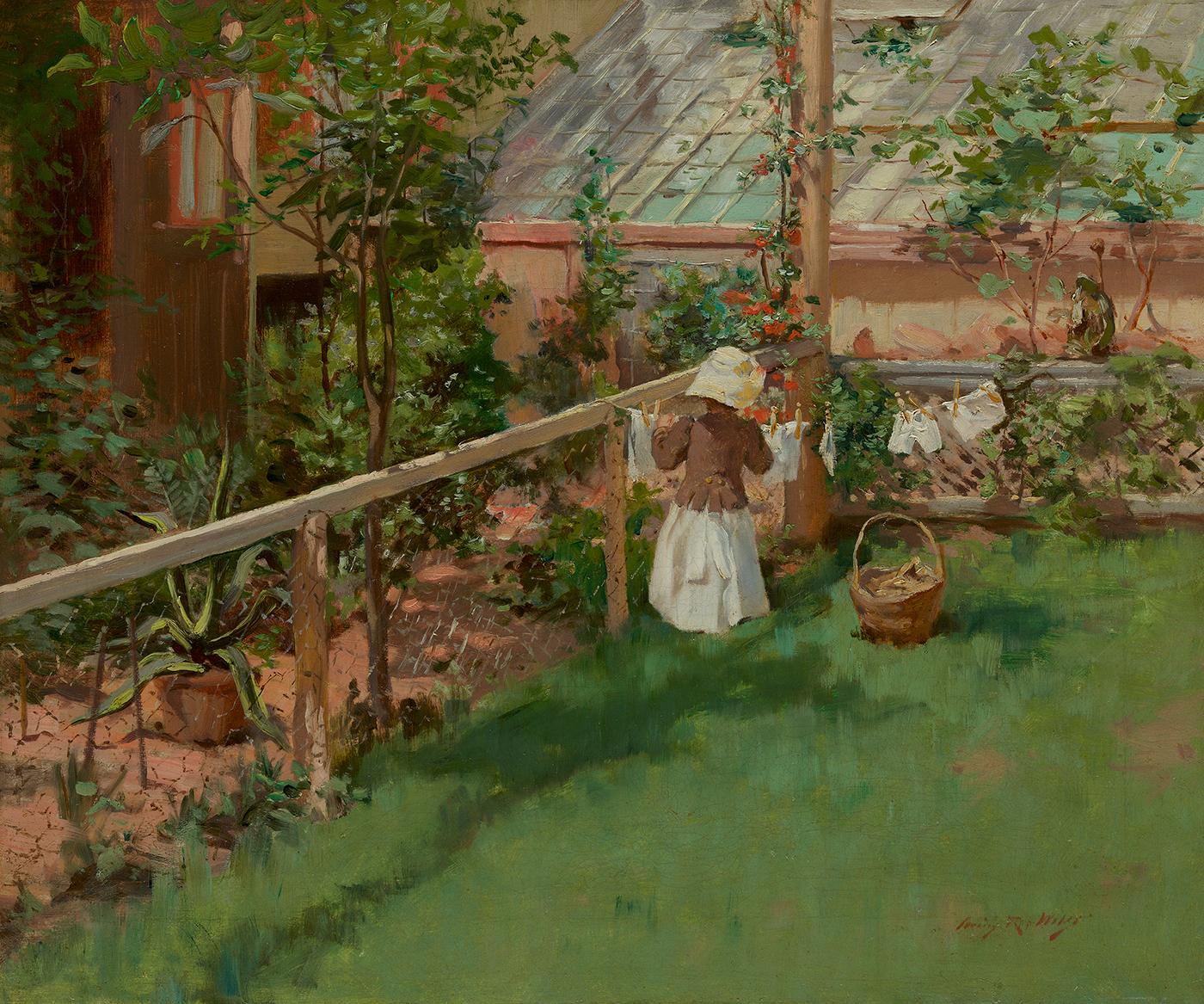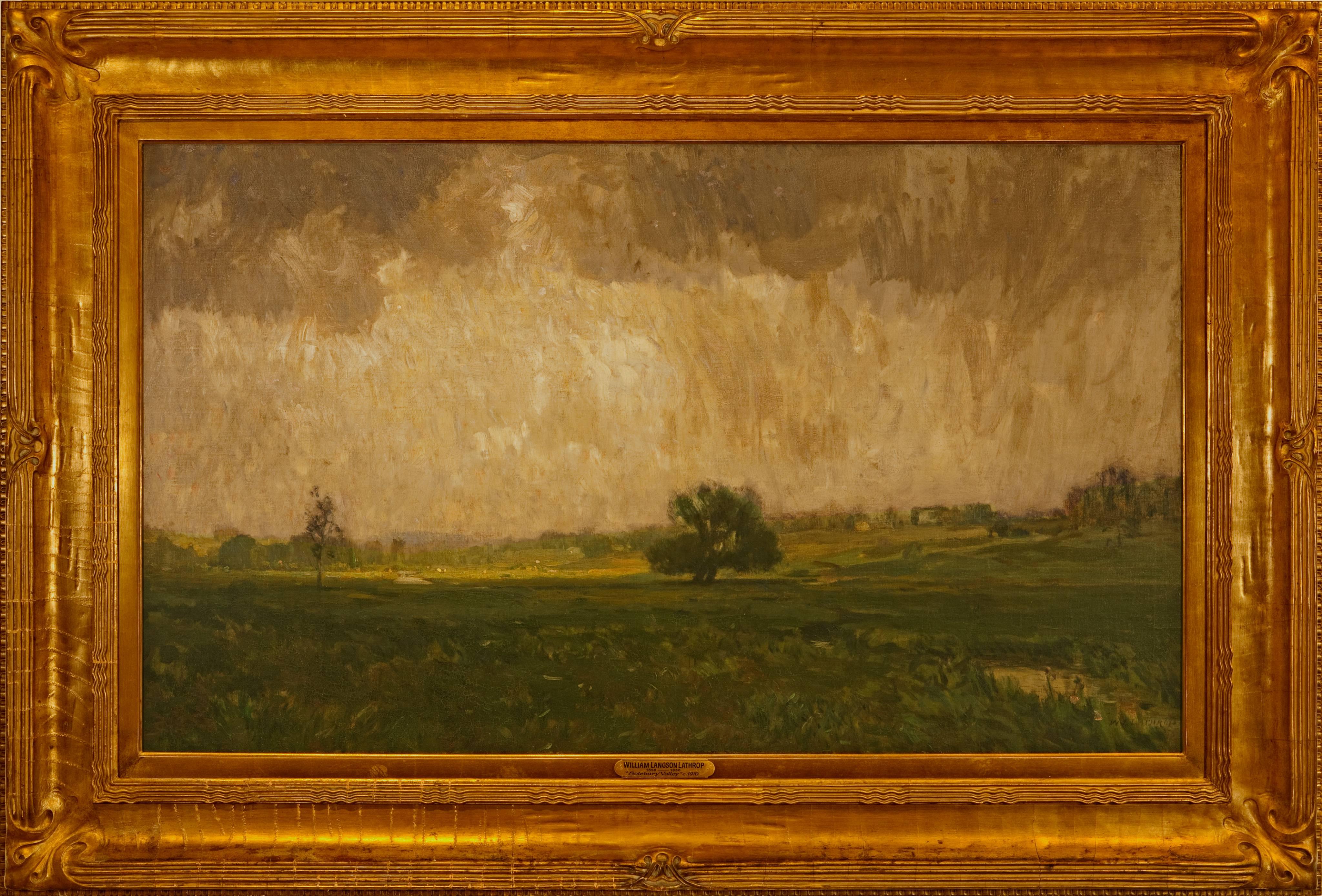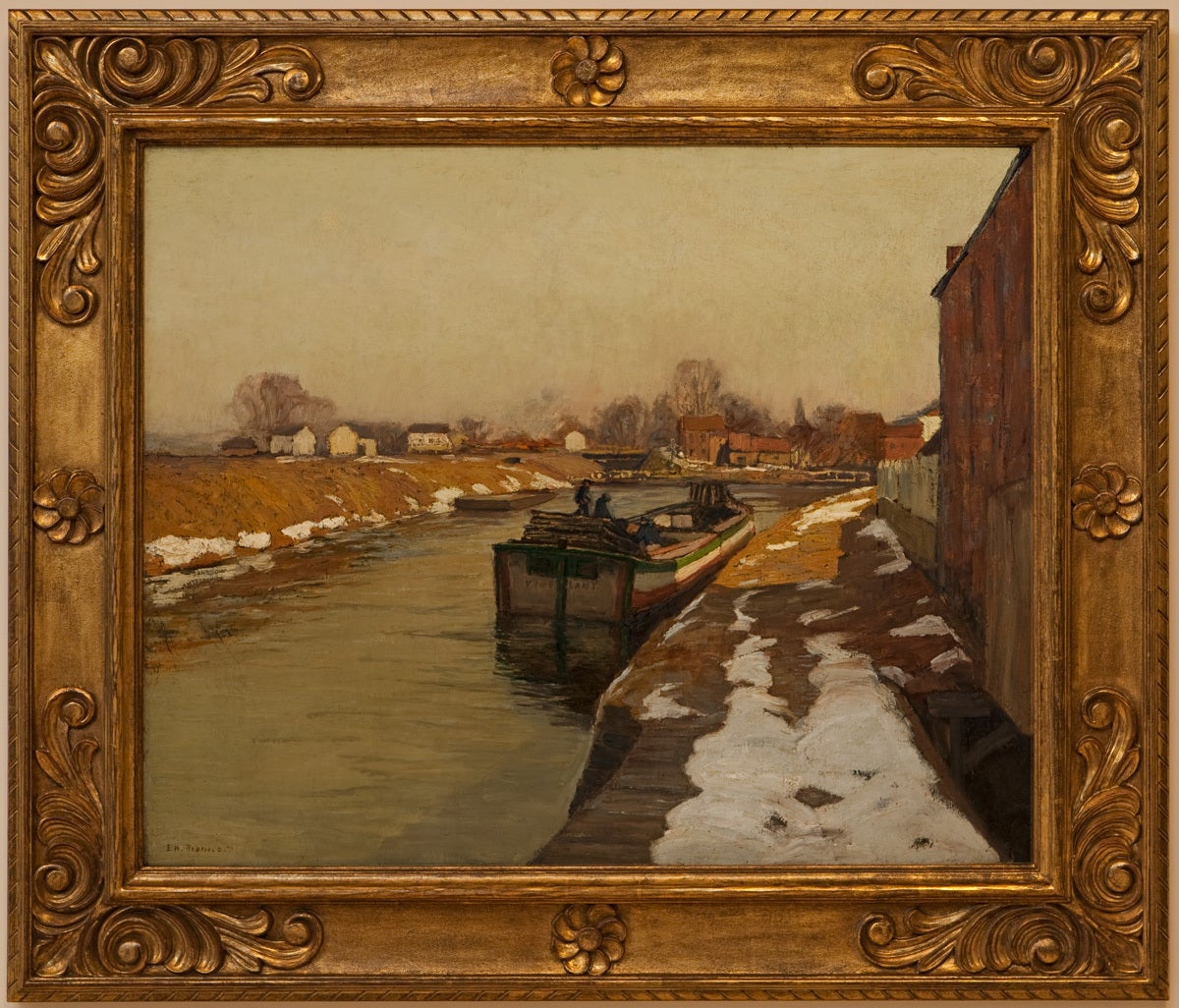Items Similar to Early 20th Century Calming Stream Landscape
Want more images or videos?
Request additional images or videos from the seller
Joline Butler SmithEarly 20th Century Calming Stream Landscape1890's
1890's
About the Item
A wonderful turn of century landscape of a stream in wooded glen by American artist Joline Butler Smith (American, 1849-1946). Signed lower right corner. Condition: Very good: One tear and two abrasions professionally repaired; inpainted. Unframed. Image size: 14"H x 17"W. (Last image is "before".)
Joline Butler Smith, whom lived most his life in Madison, Connecticut, was a landscape and portrait painter. He attended the first class at Yale School of The Fine Arts, 1869-70 (certificate; awarded B.F.A. 1898) and served as librarian at the school from 1877 to 1878. In 1887, he studied at the Atelier of Gerome and The Academie Julian in Paris, and exhibited that same year a painting entitled "Going Home" at The National Academy of Design in new York City.
Smith was associated for several years with the Tiffany Glass Company in New York City, where two windows painted by him entitled Autumn and Spring were loaned by Tiffany and exhibited at the Architectural League of New York, also in 1887. Additional Tiffany commissions were the Davenport Group and three south windows in Center Church, New Haven, as well as new churches in New York City and elsewhere in the United States.
He exhibited sketches at the Kit Kat Club, N.Y.C. with posters by Will H. Bradley in 1896, and maintained an art glass studio at 149 Orange St., New Haven for designing and painting stained glass windows from 1898 to 1916. Local glass commissions include First Methodist Church, St. Paul's Church and the chapel at Evergreen Cemetery, New Haven; Congregation Church, West Winsted and others.
From 1902 to 1906 he served as assistant in Illustration and Decorative Design, Yale School of The Fine Arts with John F. Weir and John Niemeyer. Engaged in landscape, portrait painting and stained glass window design, he was a member of the New Haven Paint And Clay Club, and exhibited at it's charter exhibition in 1900 and twelve additional times until 1921. He was also a member of the Acorn Club.
Studies at historical archives in Madison have revealed that he also drew sketches of a historical home, the Thomas Wilcox Homestead in then East Guilford, Connecticut. Though unsigned, accompanying written documents prove the sketch to be by his hand. A handwritten note explains how Smith tore down the house and used the lumber to build a new one, which was bought by the Shoreline Universalist Church as their meetinghouse in 1968.
- Creator:Joline Butler Smith (1849 - 1946, American)
- Creation Year:1890's
- Dimensions:Height: 14 in (35.56 cm)Width: 17 in (43.18 cm)Depth: 1 in (2.54 cm)
- Medium:
- Movement & Style:
- Period:
- Condition:One tear repair right edge and two abrasions; Re-touch to painting where paint missing. During cleaning the signature paint became unstable and had to augmented to replace the losses during varnish removal. We certify this to be by the artist.
- Gallery Location:Soquel, CA
- Reference Number:
About the Seller
4.9
Platinum Seller
These expertly vetted sellers are 1stDibs' most experienced sellers and are rated highest by our customers.
Established in 1986
1stDibs seller since 2014
2,531 sales on 1stDibs
Typical response time: <1 hour
- ShippingRetrieving quote...Ships From: Soquel, CA
- Return PolicyA return for this item may be initiated within 14 days of delivery.
More From This SellerView All
- Monterey Coastal Mountains LandscapeBy Jack LynnLocated in Soquel, CAGorgeous plein air landscape painting of green fields with California mountains and the coast in the background by Monterey area artist Jack Lynn (American, 20th Century). Unframed. ...Category
1990s American Impressionist Landscape Paintings
MaterialsOil, Canvas
- Mendocino Homestead, Vintage 1970's Northern California LandscapeBy Jon BlanchetteLocated in Soquel, CABeautiful plein air landscape of an old Mendocino country house by listed artist Jon Blanchette (American, 1908-1987). Signed "Jon Blanchette" lower right. Presented in a giltwood ...Category
1970s American Impressionist Landscape Paintings
MaterialsOil, Canvas, Cardboard
- A Winter Scene - Snowy 1930's LandscapeBy Frederick R. WagnerLocated in Soquel, CASerene winter landscape of a snow covered hills with a frozen creek and far off house in the distance by Frederick Wagner (American, 1864-1940), c.1930's. Signed "F. W." lower right....Category
1930s American Impressionist Landscape Paintings
MaterialsCanvas, Oil
- Man and His Guitar FigurativeBy Michael William EgglestonLocated in Soquel, CAContemporary oil painting of a man playing his guitar on the front porch by San Francisco artist Michael William Eggleston (American, 20th century). From a collection of his works. M...Category
Early 2000s American Impressionist Figurative Paintings
MaterialsCanvas, Oil
- Stowe Vermont Village Sleigh Ride, Mid Century Winter Figurative LandscapeBy Walter Thomas SacksLocated in Soquel, CAStowe Vermont Village Sleigh Ride - Mid Century Winter Figurative Landscape A bright, crisp morning and a sleigh ride through new snow in Stowe, Vermont...Category
1940s American Impressionist Landscape Paintings
MaterialsCanvas, Oil
- Mid Century Monument Valley Desert Landscape -- Navajo Hogan and Rug LoomBy Ralph HolmesLocated in Soquel, CASubstantial and period mid-century landscape of Monument Valley, Arizona of Navajo Hogan and rug weaving loom by Ralph Holmes (American, 1876-1963). c.194...Category
1940s American Impressionist Landscape Paintings
MaterialsCanvas, Oil
You May Also Like
- At the ClotheslineBy Irving Ramsey WilesLocated in New York, NYSigned lower right: Irving R. WilesCategory
Late 19th Century American Impressionist Landscape Paintings
MaterialsCanvas, Oil
- "Alley Fiends"By John R. GrabachLocated in Lambertville, NJJim’s of Lambertville is proud to offer this artwork by: John R. Grabach (1886 - 1981) John Grabach was a highly regarded New Jersey artist, teacher, and author of the classic text...Category
1930s American Impressionist Landscape Paintings
MaterialsCanvas, Oil
- "Forest Strongholds"By John F. CarlsonLocated in Lambertville, NJSigned lower right. Complemented by a hand carved and gilt frame. Exhibited at the National Academy of Design, 1928Category
20th Century American Impressionist Landscape Paintings
MaterialsCanvas, Oil
- "Solebury Valley"By William Langson LathropLocated in Lambertville, NJSigned lower right. Complemented by a period frame. William L. Lathrop (1859-1938) Deemed “Father of the New Hope Art Colony”, William Langson Lathrop was born in Warren, Illinois. He was largely self-taught, having only studied briefly with William Merritt Chase in 1887, at the Art Students League. Lathrop first moved east in the early 1880s, and took a job at the Photoengraving Company in New York City. While there, he befriended a fellow employee, Henry B. Snell. The two men became lifelong friends and ultimately, both would be considered central figures among the New Hope Art Colony. Lathrop's early years as an artist were ones of continuing struggle. His efforts to break through in the New York art scene seemed futile, so he scraped enough money together to travel to Europe with Henry Snell in1888. There he met and married an English girl, Annie Burt. Upon returning to New York, he tried his hand at etching, making tools from old saw blades...Category
1910s American Impressionist Landscape Paintings
MaterialsCanvas, Oil
- Winter MoonlightBy George William SotterLocated in Lambertville, NJsigned lower rightCategory
1910s American Impressionist Landscape Paintings
MaterialsCanvas, Oil
- "The Canal"By Edward Willis RedfieldLocated in Lambertville, NJJim’s of Lambertville is proud to offer this artwork. Signed lower left. Complemented by a hand carved and gilt frame. Illustrated in "Edward Redfield: Just Values and Fine Seeing" by Constance Kimmerle and the Pennsylvania Academy of the Fine Arts's Exhibition of Paintings by Edward Redfield (April 17 to May 16, 1909) brochure Edward Willis Redfield (1869 - 1965) Edward W. Redfield was born in Bridgeville, Delaware, moving to Philadelphia as a young child. Determined to be an artist from an early age, he studied at the Spring Garden Institute and the Franklin Institute before entering the Pennsylvania Academy from 1887 to 1889, where he studied under Thomas Anshutz, James Kelly, and Thomas Hovenden. Along with his friend and fellow artist, Robert Henri, he traveled abroad in 1889 and studied at the Academie Julian in Paris under William Bouguereau and Tony Robert-Fleury. While in France, Redfield met Elise Deligant, the daughter of an innkeeper, and married in London in 1893. Upon his return to the United States, Redfield and his wife settled in Glenside, Pennsylvania. He remained there until 1898, at which time he moved his family to Center Bridge, a town several miles north of New Hope along the Delaware River. Redfield painted prolifically in the 1890s but it was not until the beginning of the twentieth century that he would develop the bold impressionist style that defined his career. As Redfield’s international reputation spread, many young artists gravitated to New Hope as he was a great inspiration and an iconic role model. Edward Redfield remained in Center Bridge throughout his long life, fathering his six children there. Around 1905 and 1906, Redfield’s style was coming into its own, employing thick vigorous brush strokes tightly woven and layered with a multitude of colors. These large plein-air canvases define the essence of Pennsylvania Impressionism. By 1907, Redfield had perfected his craft and, from this point forward, was creating some of his finest work. Redfield would once again return to France where he painted a small but important body of work between 1907 and 1908. While there, he received an Honorable Mention from the Paris Salon for one of these canvases. In 1910 he was awarded a Gold Medal at the prestigious Buenos Aires Exposition and at the Panama-Pacific Exposition of 1915 in San Francisco, an entire gallery was dedicated for twenty-one of his paintings. Since Redfield painted for Exhibition with the intent to win medals, his best effort often went into his larger paintings. Although he also painted many fine smaller pictures, virtually all of his works were of major award-winning canvas sizes of 38x50 or 50x56 inches. If one were to assign a period of Redfield’s work that was representative of his “best period”, it would have to be from 1907 to 1925. Although he was capable of creating masterpieces though the late 1940s, his style fully matured by 1907 and most work from then through the early twenties was of consistently high quality. In the later 1920s and through the 1930s and 1940s, he was like most other great artists, creating some paintings that were superb examples and others that were of more ordinary quality. Redfield earned an international reputation at a young age, known for accurately recording nature with his canvases and painting virtually all of his work outdoors; Redfield was one of a rare breed. He was regarded as the pioneer of impressionist winter landscape painting in America, having few if any equals. Redfield spent summers in Maine, first at Boothbay Harbor and beginning in the 1920s, on Monhegan Island. There he painted colorful marine and coastal scenes as well as the island’s landscape and fishing shacks. He remained active painting and making Windsor style furniture...Category
Early 1900s American Impressionist Landscape Paintings
MaterialsCanvas, Oil
Recently Viewed
View AllMore Ways To Browse
Antique Window Designs
Archive Early 20th Century Paintings
Landscape 1898
S Glass Window
Antique Butler
Antique Butlers
Thomas Downing Paintings
Stained Glass Window Design
John Butler
S Butler
S Julian
Wooded Landscape
Thomas Hand Landscape Painting
Thomas Stream
Two Stained Glass Windows
Church Stain Glass Windows
17c Portrait Paintings
Autumn Landscape 20th Century Oil





